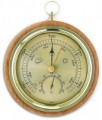Types of measurements that can be made using a thermometer.
— Internal
temperature. Measurements of indoor air temperature. Note that measurements of water and soil temperature in thermometers for the appropriate purpose (see above) are also considered internal.
— Outside temperature. Taking outdoor air temperature can be challenging due to the constant changes and various external factors like precipitation, wind, and dust. Using a thermometer designed specifically for outdoor conditions is crucial, as regular indoor thermometers may not withstand these elements. Some models come equipped with external sensors, including wireless options, to facilitate accurate outdoor temperature measurements.
—
Humidity. Measuring relative air humidity is vital for assessing comfort and well-being, as it is a key factor alongside temperature. Dry air can make heat more tolerable, but both low and high humidity levels can be uncomfortable at room temperature. This function becomes crucial in maintaining a suitable microclimate, especially when there are small children in the house, as they require a specific and controlled environment for their well-being.
—
Atmospheric pressure. Changes in atmospheric pressure not only affect how you feel, but also allow you to predict the weather with some degree of accuracy: for example, precipitation is us
...ually associated with low pressure.
In some advanced models, other, more specific measurements may be provided — for example, an assessment of the level of carbon dioxide with a warning about the need for ventilation, or the calculation of the dew point (a complex indicator that also affects the comfort of staying indoors).Total allowable measurement range. The minimum / maximum temperature that the thermometer is able to fix, as a rule, is also acceptable for using the device — with further cooling / heating, malfunctions are possible up to complete failure.
Low values of this parameter are crucial for outdoor dryer models. Additionally, the inherent "margin of safety" in measuring systems often results in finding sub-zero temperatures in purely indoor models. This feature can be practical, such as assessing conditions in an unheated room during winter.
Most contemporary household thermometers boast a maximum temperature range of 50 — 60 °C, sufficient for even relatively hot climates. However, there are less heat-resistant models with temperatures ranging from 30 — 40 °C. Thermometers designed for water applications have a lower maximum temperature, as it is not necessary for their intended use. Sauna thermometers typically exhibit the highest temperature resistance.

